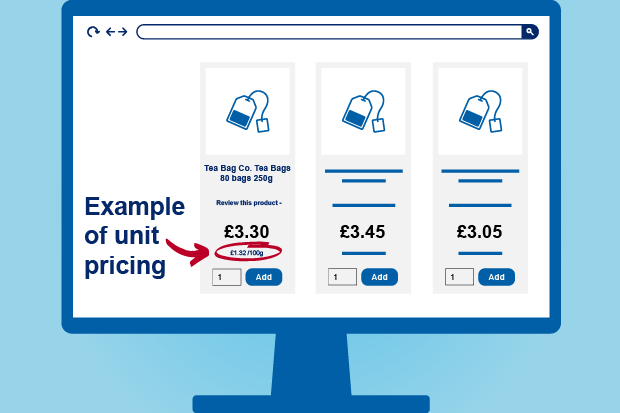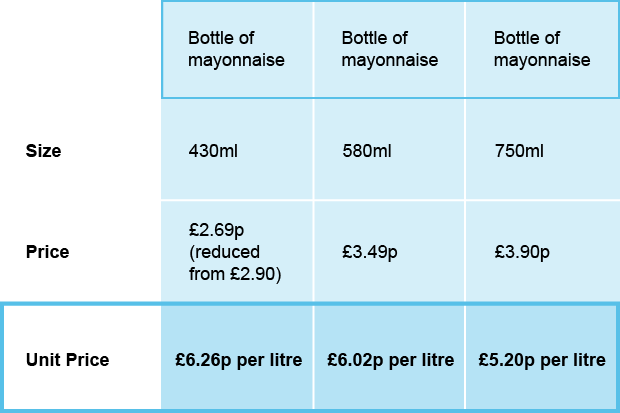
What kind of shopper are you? Do you buy exactly the same things when you shop? Or maybe you’re happy with whatever’s on offer?
However you like to shop, we all know there’s pressure on household budgets right now. People are really aware of the cost of living, and we’re all looking for ways to save money.
Unit pricing can be a good way to check you are getting value for money at the supermarket. We’ve put together this short guide to help you understand what unit pricing is, and how it can help you make smart choices.
You won’t become a millionaire overnight, of course. But over time, these little savings can add up, so it’s worth thinking about. We’ve also published some research into this if you’d like to know more.
What is unit pricing and how can it help you?
Unit pricing is when the price of an item is provided using a standard measure. This might be by:
- weight (for example kilo or gram)
- volume (for example litre or millilitre)
- quantity (for example per item)
Where can I find unit prices?
You can find unit prices on the shelf label in store and online. They’re usually displayed next to or below the selling price of the item. The unit price may be in smaller print, and so you may need to look harder if there is a loyalty or promotional offer happening.
Here’s how a unit price might be displayed on a shelf label:

Here’s how a unit price might be displayed online:

How unit pricing helps you spot the best value for money
There are a number of common assumptions out there about how to get the best value for money. Our analysis found the unit prices of some products compared to others can be surprising.
You should know that:
- bigger pack sizes don’t always offer the best value for money
- items on a promotional offer aren’t necessarily the best value for money
- items sold as part of a multi-pack aren’t always going to be cheaper than buying as individual items
- pre-packaged bags of fruit and vegetables aren’t always cheaper than loose
So check the unit price on the label before you buy.
Here’s an example that shows that items on a promotional offer aren’t necessarily the best value for money:

Beware! Unit prices can change, so they’re worth checking
It’s always worth checking the unit price of items when shopping, whether you're doing so online or in a store. We know that some shoppers have favourite items that they always buy, and you might be one of these people. But do check the unit price, because they:
- can change over time
- may be different depending on where you are shopping
- may not be the same as the last time, or even first time, you bought the item
Find out more
To learn more about unit pricing, read our latest report and related consumer research.
8 comments
Comment by Charles Dytham posted on
Apart from when there is a separate price label of Clubcard price, but with no unit pricing.
Comment by William Moore posted on
Now i do unit pricing on 90% off my shopping.
I get wound up when shops change between meserments like per 100g or per kilo it just makes you stop and have to think and sometimes when things are on offer like club card price or nectar price they do not even show a unit price.
Comment by netty posted on
It would have been better if you explained how people can work out the price per gram or per milliliter; you haven't done that. You just point people to look at whatever is on the label. Sometimes you need to have more understanding of how to work it out eg when there are three packs for the price of two.
Comment by Mrs J Platt posted on
Unfortunately failings in arithmetic mean unit prices are not always accurate. I've pointed out more than one at my local supermarket. Don't always have time to spare to report, but always notice.
Comment by Kimball Johnson posted on
This would be great, if the same type of pricing was used across packaging. It’s really common to see individual items priced by weight and packages to be priced by unit, which are not comparable
Comment by k S posted on
It's a great idea except supermarkets are not that dumb. They'll have goods by weight, volume, number of items, and without scales.. so how do you easily compare if you don't know the weight of various fruit and veg?
And, when on offer, be it a discount, 3 for 2, get one free etc.. often they don't have the adjusted weight of buying several at the discounted price.
Comment by Tessa Coburn posted on
What is the point of unit pricing when supermarkets sell tomatoes, for example, some of which are priced per item and others per kilogram, so there is no possibility of comparing relative costs. Why not compel them to display price per kilogram for all products?
Comment by Martin posted on
My local supermarket sells pick n mix sweets without any unit price. They have 3 different sizes of paper cup which you cram as many sweets in as you can for a fixed price. I have no idea which cup size offers the best value, or how this compares with other shops that charge per 100g. There aren't even any scales to weigh what you buy.